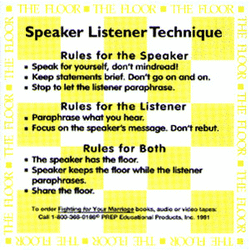 On a previous video/blog we discussed reasons why one member of a couple might not want to work on communication. But if you’re the one who wants to, then what? I think there are at least two things you can do: (1) learn to be a better listener yourself, and (2) learn how to set appropriate boundaries in the relationship. Let’s start with learning how to be a better listener. This stuff is straight out of counseling training. Counselors use several non-verbal behaviors to help people understand they are being listened to. These behaviors can be remembered by the acronym SOLER:
Sitting squarely. Turning away from someone while they speak communicates to them that you’re not listening. Likewise, turning toward someone communicates “I’m hearing you”. So an easy thing to do that helps your spouse know you are hearing them is to sit facing them. You can be directly across from them, or at a slight angle. When sitting squarely, it’s important to be aware of how close you are to the other. As a general rule in American culture, being less than 18 inches away can make them uncomfortable. And generally people with closer relationships will sit closer together while those less comfortable around each other will stay further apart. Open posture. Like the photo shows, how we have our arms can communicate without saying a word. Folded arms can communicate defensiveness, disgust, or anger (notice the man on the left). Likewise a more open posture can non-verbally tell someone I am willing to listen without judging (notice the man on the right). We may not mean anything by how we sit or stand, but if the other person is reading it that way, it’s worth considering. Lean toward the speaker. Leaning away from a speaker is something people generally do to indicate wariness, distrust, disagreement or boredom. Leaning toward usually indicates the opposite. It shows that you are interested in them and what they have to say. Eye contact. Good eye contact demonstrates that your focus is on the speaker. Good eye contact isn’t staring the other person down, instead it involves looking directly at their face and occasionally shifting your gaze to other parts of the body. Relax. Relaxing here means doing these non-verbals in a natural or un-planned way. Doing what “comes naturally”. “And how is that possible?” you ask. Don’t expect it to be at first. But as you practice these non-verbal techniques they will become more natural. I said earlier that you may do some of SOLER actions already. But chances are that time, frustration, conflict, etc. have worn away the natural inclination you have to do to the things that indicate you’re interested in what he has to say. In fact, you’re probably not interested. But the good news is that you can re-learn them, or learn them in the first place if needed. Speaker-listener cards are another tool that can be used to facilitate good communication. Just follow the instructions on the card. Like the non-verbal listening skills, the speaker-listener cards might seem awkward at first, but will become more natural over time. We’ve gone over a number of techniques to help with communication. But if your spouse isn’t willing to put forth some effort in this area, it may be necessary to establish some boundaries. More on that next time.
3 Comments
|
Archives
October 2021
Categories
All
|
 RSS Feed
RSS Feed